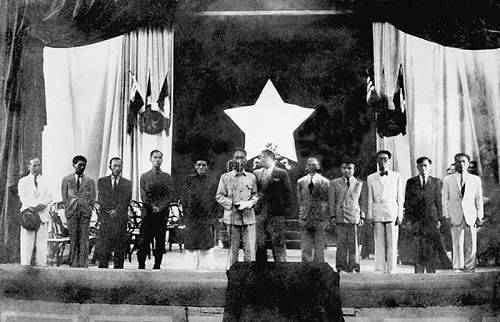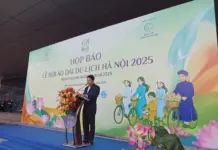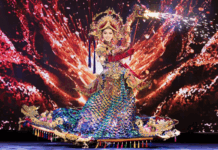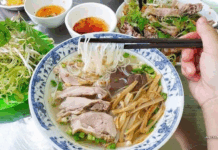In a historic document, late Prime Minister Pham Van Dong of North Viet Nam (the Democratic Republic of Viet Nam) wrote: “Ngo Tu Ha is a patriot who has participated very early in the Viet Minh movement [the League for the Independence of Vietnam that later became the government of North Vietnam]. He has often met Uncle Ho and is on familiar terms with me.”
| President Ho Chi Minh and members of the Government were sworn in at the first session of the first National Assembly (March 2, 1946). File Photos |
Being a patriot protesting the foreign invasions, Ha was soon alive to the revolution. As the owner of the Ngo Tu Ha Printing House, he provided Viet Minh troop with materials and technology to print clandestine newspapers and leaflets that calling on people to rise up in the August Revolution of 1945, which was one of the greatest landmarks in Vietnam’s history, formally marking the end of French colonialism and the beginning of an independent Vietnam.
The young revolutionary government in the early days had faced many difficulties, including its best efforts to eliminate hunger, illiteracy, and foreign invasion, and the exhaustion of the national treasury.
Meanwhile, Chiang Kai-shek’s troops entered the North with China’s national currency, having devaluated the local currency and posed a high risk of inflation.
| Ngo Tu Ha’s printing house. File Photos |
At that time, Vietnam was part of the French Indochina so we used the currency of the whole Indochina that was “Piastres” (means “dong” in Vietnamese).
In such a difficult time, the government defined the need to have a unified monetary system to fighting inflation and ensuring spending. It required the issuance of a new currency.
On January 31, 1946, the Ngo Tu Ha Printing House was selected to print the first paper money for the Government of the Democratic Republic of Vietnam. The banknotes, printed with the portrait of beloved Uncle Ho, had par values of 100 dong, 50 dong, 20 dong, 10 dong, 5 dong, 2 dong and 1 dong. They all were transported to the Ministry of Finance for being signed and stamped with serial numbers before issuance.
| The first-ever banknotes with the image of beloved Uncle Ho. File Photos |
The banknotes were issued in a timely manner, not only meeting the spending needs of the Government and people but also affirming the nation’s independence and sovereignty.
French colonialists burnt the Ngo Tu Ha printing house right after they began the re-invasion of North Vietnam on December 19, 1946.
The house at 24 Ly Quoc Su Street (Hoan Kiem District, Hanoi) is now the vestige of the Ngo Tu Ha Printing House.
Twenty-seven years serving NA
After the success of the August Revolution in 1945, with the support of the Viet Minh and a large majority of voters in his hometown in the northern province of Ninh Binh, Ha was elected as a member of the first session of the first National Assembly in 1946. At the age of 63, he became the oldest member of the National Assembly.
At the first session of the National Assembly held on March 2, 1946, Ha was appointed as chairman of the session who read the opening statement and the manifesto of the National Assembly of Vietnam. He was also elected as a member of the National Assembly Standing Committee.
In the early days of building the new government, Ha was an advisor of revolutionary leader Ho Chi Minh, helping him make important decisions in building up the country, including suggesting the date for the Declaration of Independence, which then became the National Day of Vietnam falling on September 2.
Among the photos that Ha’s family has kept until now, there are some photos of him sitting next to President Ho Chi Minh and revolutionists Huynh Thuc Khang and Nguyen Van To, especially the event of praying for two million people starved to death at the Hanoi Cathedral in 1945, the year of the Rooster.
Ha was also the person who acted as a link between President Ho Chi Minh and King Bao Dai, the last king of the Nguyen Dynasty (1802-1945).
It’s told that during the time managing a printing house in Hue, an ancient city of Vietnam’s central region, Ha had a good relationship with some mandarins and made acquaintance with King Bao Dai. That’s why President Ho Chi Minh had appointed him as a negotiator to persuade the king to abdicate and accept the role of an advisor for the new government.
| Ngo Tu Ha (middle) participated in a campaign of hunger relief in 1945. File Photos |
King Bao Dai had a famous saying “I would rather live as an ordinary citizen of an independent country than be Emperor of a nation of slaves.”
When the nationwide resistance war broke out in 1946, Ha went to Switzerland. He came back in 1954 with the Vietnamese government’s delegation led by Deputy Prime Minister and Minister of Foreign Affairs Pham Van Dong in the glory of the victors after the successful negotiation at the Geneva Conference in 1954, in which the French agreed to withdraw their troops from Vietnam.
In 1954, at the age of 72, Ha continued to perform his duties in the first session of the National Assembly Standing Committee.
He was an active member and one of the founders of the League for the National Union of Vietnam. He was elected as a member of the Presidium of the Central Committee of the Vietnamese Fatherland Front, which was established on September 10, 1955.
He was also a member of the Liaison Committee for Vietnamese Patriotic and Peace-Loving Catholics, chairman of the national association to help soldiers with difficulties, and Deputy Minister of War Invalids and Veterans (later the Ministry of Labour, War Invalids and Social Affairs).
On August 8, 1973, Ha passed away at the age of 92. His active life is a shining example of a patriotic national bourgeois, an exemplary National Assembly member.
translated by Hanoitimes


.jpg)
.jpg)




